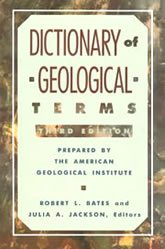Geological Terms Beginning With "A"
For terms beginning with other letters, please click below
|

Aa
A term of Hawaiian origin. Used in reference to a basaltic lava flow that has a fissured, rough, clinkery, or jagged surface. When cool, they are very difficult to walk on.
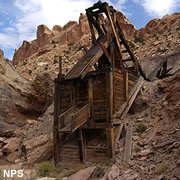
Abandoned Mine Lands
Areas where past mining activity has scarred the land surface, streams, or groundwater. These lands might be owned by persons, companies, organizations, or government agencies. Abandoned mine lands are dangerous places. Every year in the United States, accidents at abandoned mines and quarries claim numerous lives.
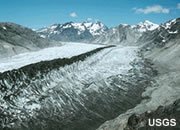
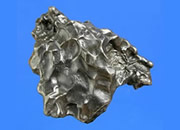
Ablation (meteorites)
The removal of surface material from a meteoroid as it passes through Earth's atmosphere. The removal is caused by air molecules impacting the meteoroid, which is probably traveling at a speed of at least 20 kilometers per second. Trails of these ablated particles are often visible from Earth as a bright streak of light sometimes called a "shooting star" or a meteoroid trail.
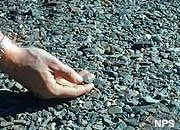
Ablation (sediment and soil)
The removal of small-size soil and sediment particles from a land surface by the persistent action of wind. Eventually all of the particles that can be carried by the wind will be removed, leaving a rocky surface known as a "desert pavement." The desert pavement surface shown here is on an alluvial fan in the Providence Mountains State Recreational Area of California.
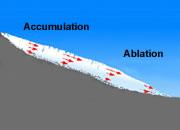
Ablation Zone
The lower portion of a glacier where, over the course of a year, more ablation than accumulation occurs.
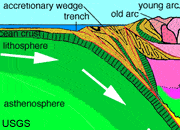
Accretionary Wedge
A mass of sea floor sediment that accumulates at the boundary between a converging oceanic plate and continental plate. This sediment is being scraped off the top of the oceanic plate as it is forced under the continental plate. It "accretes" at the point of plate collision, and that is where the name originates.

Accumulation Zone
The upper portion of a glacier where, over the course of a year, more accumulation occurs than ablation and the mass of glacial ice grows.
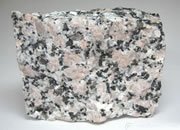
Acidic Rock
An igneous rock that has a relatively high silica content. Examples are granite and rhyolite. Also see entries for basic, intermediate, and ultrabasic rocks. The photo is a specimen of pink granite about two inches across.
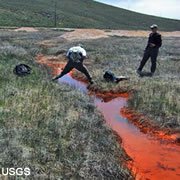
Acid Mine Drainage (AMD)
Acidic water discharged from a mining operation. The acid is usually produced by the reaction of sulfide minerals newly exposed to oxygen during the mining process. The acid waters usually carry dissolved metals which precipitate downstream as the acid is diluted by other water sources. The acid is neutralized by the dilution and the water is unable to carry the dissolved metal ions. Coal mines and metal mines are the typical sources of acid mine drainage. Today, active mines are required to have treatment systems that prevent the release of acid waters. Abandoned mines are typically the source of acid discharge and can continue to produce acid discharge for decades without remediation. The photo shows a seep draining mine tailings along Silver Creek, near Park City, Utah.
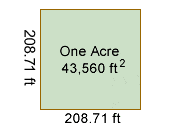
Acre
An acre is a unit of land measure that represents 43,560 square feet or 1/640 of a square mile. A square property that is 208.71 feet long and 208.71 feet wide is approximately one acre.
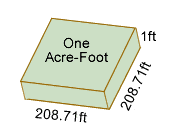
Acre-Foot
The volume of water needed to flood one acre of land to a depth of one foot. Equivalent to 43,560 cubic feet, 1,233 cubic meters, or 325,851 gallons. The acre-foot is one of the most common units of measure used for reservoir capacity. Also used in mineral resource calculations (an acre-foot of coal is a block of coal one acre in area and one foot thick - it weighs approximately 1,800 tons).

Acreage
An area, measured in acres, that is owned or controlled by one or more owners or lessees. "Gross Acreage" is the entire geographic area under control. "Net Acreage" is the gross acreage multiplied by the fractional share of any individual owner or lessee.
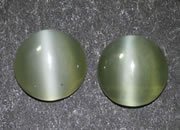
Actinolite (Cat's Eye)
Actinolite is green to grayish green mineral of the amphibole group found in metamorphic rocks. It sometimes has a fibrous texture that produces a strong cat's eye when cut en cabochon.
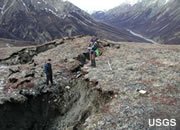
Active Fault
A fault that has slipped in historic time and which is likely to slip again in the future. Strain accumulates on active faults, and some creep slowly over time. The image shows the surface exposure of the Denali fault with approximately 5 meters of offset near the Delta River in Alaska.
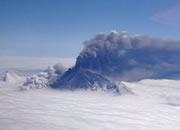
Active Volcano
A volcano that has erupted within historic time or one that is currently erupting. The photo is of Pavlof Volcano on the Alaska Peninsula, one of the most active volcanoes in North America.
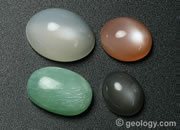
Adularescence
An optical phenomenon that defines the gem known as "moonstone." Adularescence is a soft glow of light that floats just under the surface of a polished gemstone or under the smooth surface of a gem material. This floating glow of light will move within the stone as the angle of incident light is changed, as the position of the observer's eye is moved, or as the stone is moved under the light. Adularescence is observed in some semi-translucent to transparent feldspar minerals and is caused by light entering the material and reflecting from molecular interfaces within the stone.
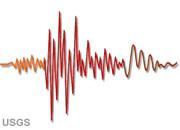
Aftershocks
Small earthquakes that follow the largest shock of an earthquake sequence. They can occur for days, weeks, months, or years after the large earthquake. The larger the main shock, the more numerous and longer the aftershock sequences.
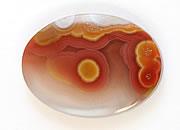
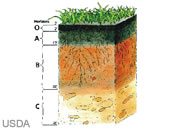
A-Horizon
A soil layer immediately below the surficial organic material. It consists of a mixture of organics and mineral matter. The majority of soil organisms live within this layer, and it may be heavily bioturbated. As water moves from the surface down through this layer, soluble constituents are removed and carried deeper into the ground.
|
Dictionary of Geological Terms - Only $19.99 All scientific disciplines have an essential vocabulary that students and professionals must understand to learn and communicate effectively. A geology dictionary that is used regularly is one of the most important tools for developing professional competence. A good dictionary should be on the desk of every geologist and within easy reach. This dictionary is compact and inexpensive at only $19.99. More information. |
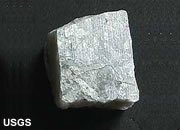
Alkali
In chemistry, an "alkali" is a strongly basic substance such as sodium hydroxide or sodium carbonate. These substances have the ability to neutralize acids to form salts. In geology, "alkali" is an adjective used in reference to silicate minerals or rocks that are rich in alkali metals such as sodium or potassium. Orthoclase, plagioclase, and microcline would be "alkali feldspars." The specimen in the photo is a cleavage fragment of plagioclase.
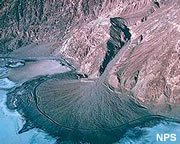
Alluvial Fan
A fan-shaped wedge of sediment that typically accumulates on land where a stream emerges from a steep canyon onto a flat area. In map view it has the shape of an open fan. Alluvial fans typically form in arid or semiarid climates. Shown in the photo is the Badwater Alluvial Fan of Death Valley.
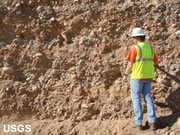
Alluvium
An unconsolidated accumulation of stream-deposited sediments, including sands, silts, clays, or gravels. Shown in the photo is an outcrop of alluvium.
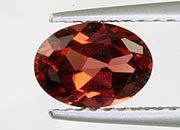
Almandine Garnet
Almandine garnet, also known as "almandite," is an iron-rich, red-to-purple garnet that is geologically very common and typically sells on the more affordable side of the garnet price range. For that reason, it is common in jewelry.

Alpine Glacier
A glacier that occurs in a mountainous region and occupies a valley. Also known as a "valley glacier."
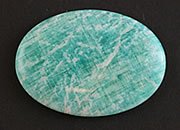
Amazonite
Amazonite is a trade name given to a light green to bright green variety of microcline feldspar. It has a Mohs hardness of 6 with perfect cleavage. It is often cut into cabochons for use in jewelry. Because it is relatively fragile, it is best used where it will not suffer abrasion or impact.
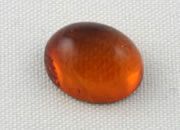
Amber
Amber is a fossilized resin secreted by ancient trees. It usually has a yellowish to orangish-brown color but can be white, greenish, bluish or even black. It is easily cut and polished into bright, lightweight gems. Amber is an organic gem material.
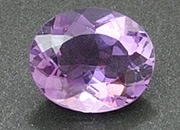
Amethyst
Amethyst is a transparent variety of quartz that ranges from light lilac to deep purple in color. It is one of the most popular faceted gemstones and is sometimes cut en cabochon. It is found in deposits around the world.
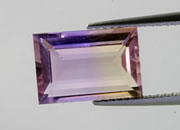
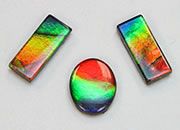
Ammolite
Ammolite is a trade name used for iridescent ammonite shell material. It produces a bright flash of color that rivals fine opal and labradorite. All of the world's commercial Ammolite production comes from a small area in Alberta, Canada.
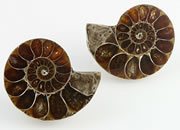
Ammonite
An extinct group of marine invertebrate animals that produced a chambered shell. Their fossilized shells are often cut and used as an ornamental or jewelry stone. Agatized ammonites are a popular organic gemstone.
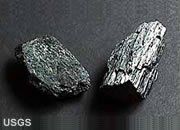
Amphibole
Amphiboles are members of a family of dark-colored ferromagnesian silicate minerals that have the generalized chemical composition of A2-3B5(Si,Al)8O22(OH)2 where A = Mg,Fe,Ca,Na and B = Mg,Fe,Li,Mn,Al. They occur in prismatic crystals that have very good cleavage in two directions, with cleavage planes intersecting at 56 and 124 degrees. They are rock-forming minerals found in igneous, metamorphic, and sedimentary rocks. Hornblende, tremolite, actinolite, and glaucophane are examples.
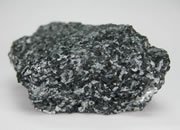
Amphibolite
Amphibolite is a non-foliated metamorphic rock that forms through recrystallization under conditions of high viscosity and directed pressure. It is usually composed primarily of hornblende and plagioclase, usually with very little quartz.
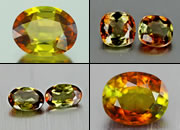
Andalusite
Andalusite is a metamorphic mineral that is strongly pleochroic and is underappreciated as a gem. A variety known as chiastolite has grains of graphite concentrated into a cross-shaped feature.
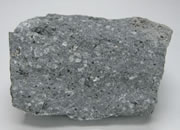
Andesite
A fine-grained, extrusive igneous rock composed mainly of plagioclase with other minerals such as hornblende, pyroxene, and biotite.
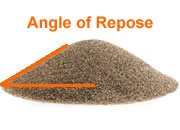
Angle of Repose
The maximum angle that a soil, sediment, or other loose, cohesionless material can be placed or accumulate and be stable from down-slope movement. The angle of repose varies for different types of materials and different moisture conditions. Image copyright iStockphoto / Barcin.
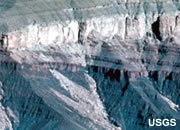
Angular Unconformity
An erosional surface that separates rock units of differing dips. The rocks below the surface were deposited, deformed, and eroded. The younger rocks above then accumulated upon the erosional surface. Shown in the photo is a section of "The Great Unconformity" of the Grand Canyon.
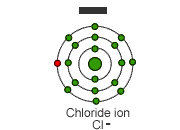
Anion
An atom with a negative charge that has been produced by the gain of one or more electrons. In the image, a chlorine atom gained one electron (red) and is now a chloride ion with a negative charge.

Ant Hill Garnet
Ant hill garnet is a novelty gem that ants excavate, haul to the surface, and deposit on their ant hill. These red chrome pyrope garnets are often found on ant hills in parts of the southwestern USA.
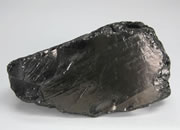
Anthracite
The highest rank of coal. By definition, a coal with a fixed carbon content of over 91% on a dry ash-free basis. Anthracite coals have a bright luster, break with a conchoidal fracture, a semi-metallic luster and are difficult to ignite. Frequently referred to by the layman as "hard coal."
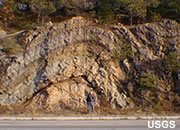
Anticline
A fold in rock strata with a convex upward shape. The rocks in the core of an anticline are the oldest. The anticline in the photo is along New Jersey Route 23 near Butler, NJ.
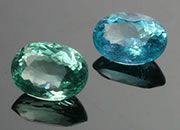
Apatite
Apatite is a phosphate mineral that is mainly used in making fertilizer. It is also cut as a gem when found in clear crystals with attractive colors. It has a hardness of 5 on the Mohs scale and is brittle. It is a "collector's gem" rather than a jewelry gem.
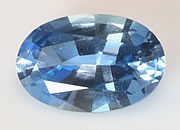
Aquamarine
Aquamarine is a blue variety of the mineral beryl. It receives its name from its seawater color. It ranges from a very light blue to a richly saturated blue, with the richer color being much more desired.
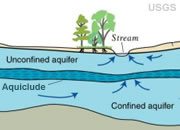
Aquiclude
The opposite of an aquifer. An aquiclude or aquitard is a subsurface rock, soil, or sediment unit that does not yield useful quantities of water. It may be porous and capable of containing water, but the transmission rate is so poor that it cannot be considered to be a water source. Clay and shale are typical aquicludes.

Aquifer
A subsurface rock or sediment unit that is porous and permeable. To be an aquifer it must have these traits to a high enough degree that it stores and transmits useful quantities of water.
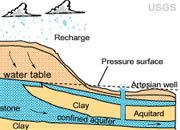
Aquifer (artesian)
An aquifer that is bounded above and below by impermeable rock or sediment layers. The water in the aquifer is also under enough pressure that, when the aquifer is tapped by a well, the water rises up the well bore to a level that is above the top of the aquifer. The water may or may not flow onto the land surface.

Aquifer (confined)
An aquifer that is bounded above and below by impermeable rock or sediment layers. There may or may not be enough pressure in the aquifer to make it an "artesian aquifer."

Aquifer (unconfined)
An aquifer that is not overlain by an impermeable rock unit. The water in this aquifer is under atmospheric pressure and is recharged by precipitation that falls on the land surface directly above the aquifer.
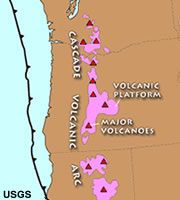
Arc
A chain of volcanoes that forms on a continental plate when an oceanic plate collides with the continental plate and subducts beneath it. Also, a chain of volcanoes that forms on an oceanic plate in a similar collision with another oceanic plate. The image shows the Cascades Volcanic Arc of the northwestern United States.
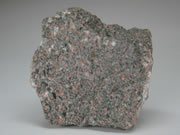
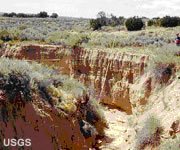
Arroyo
A flat-bottom gully with steep sides that is cut into alluvium. It serves as a channel for an intermittent or ephemeral stream. This term is commonly used in the arid and semiarid areas of the southwestern United States.
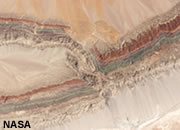
Aseismic
A fault that has never produced an earthquake that has been detected or observed by people.
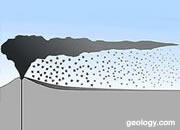
Ash (volcanic)
Rock, mineral, and volcanic glass fragments smaller than 2 millimeters in size that are blown from the vent of an erupting volcano. It is produced by the shattering of rocks during an eruption and by magma being ejected as a fine spray - propelled by volcanic gas escaping from the vent.
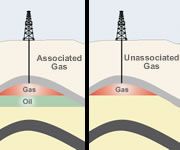
Associated Gas
Natural gas that is found in a reservoir with crude oil. The gas may be in a free gas cap above the oil within the reservoir structure because of its lighter density, or, the gas might be dissolved within the oil and come out of solution when the pressure is reduced. Associated gas is often flared (burned) when oil is produced because a collection and distribution system is not available to transport the gas to market. Flaring is a waste of a resource, a cause of pollution, and a contribution to global warming. Contrast with unassociated gas.
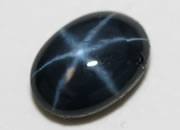
Asterism
An optical phenomenon seen as intersecting lines of light that form a star-like figure just below the surface of a cabochon-cut gem. The phenomenon is called a "star" and is seen in gems such as sapphire, ruby, enstatite, diopside, garnet, and spinel. The star is caused by reflections from a network of tiny parallel rod-shaped inclusions within the stone, known as a "silk." Each orientation of these parallel inclusions within the stone produces a single line on the surface of the stone. Four- and six-ray stars are most common.
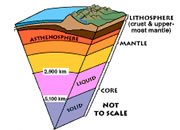
Asthenosphere
A portion of the upper mantle that is directly below the lithosphere. A zone of low strength in the upper mantle defines the top of the asthenosphere. This weak zone allows the plates of the lithosphere to slide across the top of the asthenosphere.
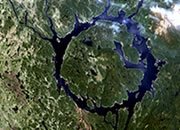
Astrobleme
An ancient circular scar on Earth's surface produced by the impact of a meteorite or comet.
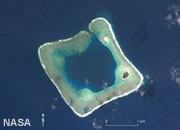
Atoll
A ring-shaped island or group of coral islands that are surrounded by deep ocean water and that enclose a shallow lagoon. The satellite image at left shows Rose Atoll. The island is about 1.5 miles across, and the central lagoon has a maximum depth of about 60 feet. A narrow passage on the northern corner of the island is the only surface connection of the lagoon to the ocean.
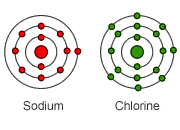
Atom
A basic unit of matter that consists of a central nucleus surrounded by shells of negatively charged electrons. The nucleus consists of positively charged protons and electrically neutral neutrons. Shown in the image is one sodium atom and one chlorine atom.
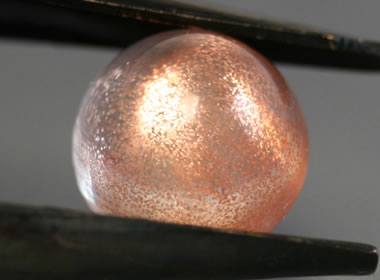
Aventurescence
An optical phenomenon that is seen as a flash of light as a gemstone is moved under a source of incident light. It is caused when many tiny platelet-shaped inclusions of a reflective mineral such as mica or copper or hematite are aligned with a common orientation within the gem material. Light entering the stone travels until it encounters one of these platelets and is then reflected. Because the platelets share a common orientation, they all reflect simultaneously and produce a quick flash of light as the stone is moved under the source of incident light. Reflections can also be seen if the light source is moved or the eye of the observer is moved. Aventurescence is the defining phenomenon of the gem material known as aventurine. It is also seen in sunstone and other materials.
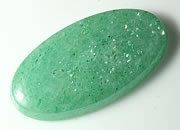
Aventurine
Aventurine is a quartz variety that contains a blizzard of tiny reflective inclusions such as muscovite, hematite, or fuchsite. Light enters the stone, reflects from the grains and produces a flash known as aventurescence.
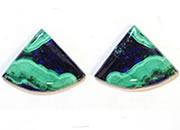
Azurite
A dark blue copper carbonate mineral that is a minor ore of copper. It is also cut as an opaque gemstone and sometimes ground to a powder for use as a pigment. Often associated with malachite and chrysocolla. It is soft (H: 3.5-4) and cleaves easily. Cut into cabochons for jewelry that will not encounter wear.
|
| More General Geology |
 |
Gifts That Rock |
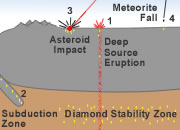 |
Diamonds from Coal? |
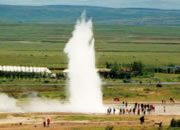 |
What is a Geyser? |
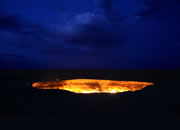 |
The Doorway to Hell |
 |
What is the San Andreas Fault? |
 |
Igneous and Volcanic Features |
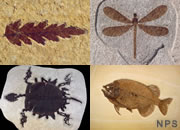 |
Spectacular Fossils |
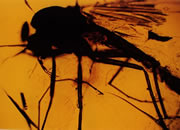 |
Bubbles in Amber |

Find Other Topics on Geology.com:

|

| ||

|

| ||

|

| ||

|

|

